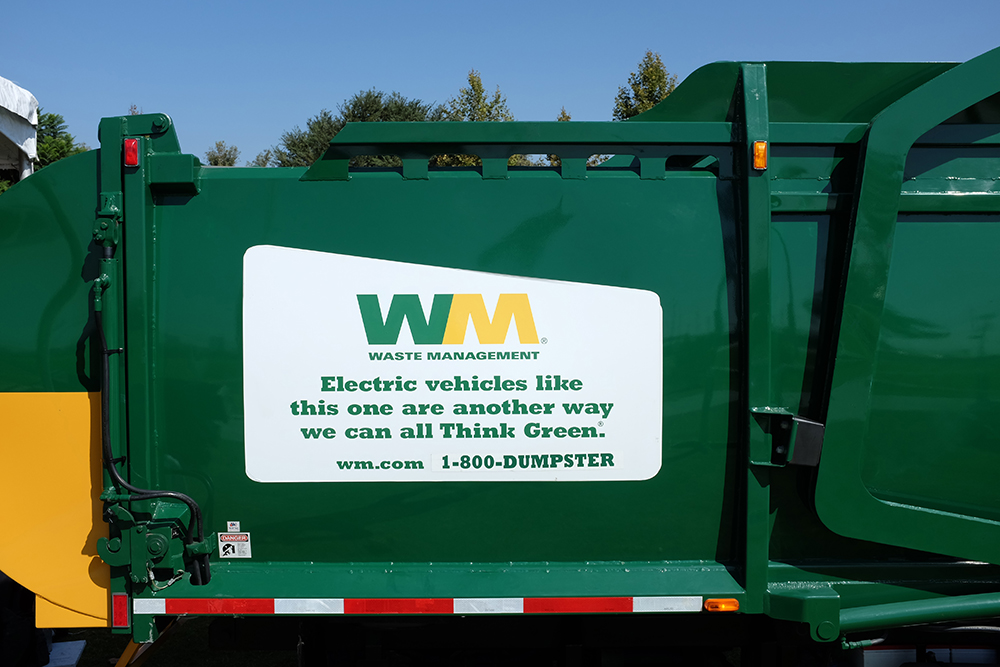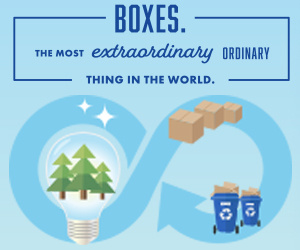
Waste Management is leaning on technology to reduce the company’s environmental impact. | Lunasee Studios/Shutterstock
Recycled-content mandates in a handful of states will have a “halo effect” that stimulates brand owner demand for recycled materials elsewhere. That’s one of the reasons WM feels confident investing $1 billion into its recycling business over four years, company executives said.
“Minimum-content legislation is one of the most favorable for the recycling industry, establishing a mandated demand for recycled materials,” Brent Bell, WM’s vice president of recycling, said during an April 5 sustainability investor day.
During the event, executives elaborated on the recycling and landfill gas recovery investments they first announced in February. For recycling capital investments, Houston-headquartered Waste Management (WM) spent $321 million in 2022 and plans to spend $455 million this year, $180 million in 2024 and $45 million in 2025, for a total of just over $1 billion.
The improvements, which include both upgrading 35 existing facilities and building eight new sorting facilities, will help WM meet its goal of increasing its sorting and marketing capacity from about 15 million tons in 2021 to 25 million tons by 2030.
Strong demand, both voluntary and mandatory
Bell noted that the only way recycling works is if there is demand for recycled materials. Strong demand typically translates into higher prices, which ultimately helps bolster municipal recycling program budgets.
WM is seeing increased commitments to buying recycled content from consumer packaged goods companies, Bell said.
“We actually meet with these companies on a regular basis, and I can tell you there is a real concern on the availability of supply for these recycled materials,” Bell said.
State regulations requiring minimum levels of recycled content in packaging and products are also driving demand. Such laws, which typically focus on plastics, have recently been passed in California, New Jersey, Maine and Washington state. California began requiring 15% post-consumer resin (PCR) in beverage containers starting in 2022. The requirement rises to 25% in 2025 and 50% in 2030.
The presentation notes those states will have a “halo effect” as producers align across multiple states.
“Someone’s not going to make a shampoo bottle just for the state of California or a soda bottle just for the state of New Jersey,” Bell said.
WM also cited extended producer responsibility (EPR) laws for printed paper and packaging that have passed in four states – California, Colorado, Maine and Oregon – and seven Canadian provinces: Alberta, British Columbia, Manitoba, New Brunswick, Ontario, Quebec and Saskatchewan.
For years, WM has included boilerplate language in its annual report noting that EPR is a risk factor for the company. “If wide-ranging EPR regulations were adopted, they could significantly impact the waste and recycling streams we manage and how we operate our business, including contract terms and pricing,” the report notes. “A significant reduction in the waste, recycling and other streams we manage could have a material adverse effect on our financial condition, results of operations and cash flows.”
But on April 5, WM’s sustainability focused presentation pointed to EPR policies as “potentially favorable legislative and regulatory tailwinds” for the recycling business. The presentation noted over a dozen other states are considering EPR legislation this year.
Seeing favorable returns
With an audience of investors, the presentation was focused on the financial returns to be expected with the capital spending.
Specifically, WM forecasts $240 million in annual adjusted operating EBITDA (earnings before interest, taxes, depreciation and amortization) by 2026, as a result of the MRF investments. For comparison, WM’s total recycling EBITDA was $15 million last year. The overall company’s adjusted operating EBITDA was $5.5 billion in 2022.
The $240 million comes from four different benefits derived from MRF upgrade and construction projects, according to the company’s projections.
Specifically, automation will improve bale quality and capture rates, resulting in an EBITDA boost of about $70 million per year. Expanding recycling capacity in existing markets will boost EBITDA by about $35 million per year. Profiting from recycling in new markets with the construction of additional MRFs will bring in $65 million each year in EBITDA. For single-stream MRFs, those new markets are Detroit; Fort Walton, Fla.; Oakland, Calif.; and Portland, Ore. For commercial recycling facilities, they are Toronto and Brooklyn, N.Y., and for C&D debris sorting plants, they are Nashville, Tenn. and Miami. Finally, reducing labor costs will provide an EBITDA benefit of about $70 million per year.
Those projections are based partly on an educated guess of a blended average commodity price of $125 per ton in coming years. That being said, of the $240 million in future EBITDA that WM touted to investors, 60% is unrelated to commodity prices, the presentation noted.
“These investments you’re seeing today, a lot of it is non-commodity driven,” Bell said, emphasizing that the company continues to sign municipal contracts with processing fees that ensure WM gets paid in down markets.
Additionally, the upgraded MRFs have much better financial performance than the non-automated ones, according to WM. The company’s new MRF in Houston, about 20 minutes away from the corporate headquarters, replaced two older facilities serving the city. According to the presentation, the new MRF boasts a 75% increase in processing capacity, a 51% reduction in recyclables in the residue, a 33% reduction in labor costs per ton and a 31% increase in average revenue per ton.
“On the recycling side, it’s about transforming our existing facilities for the future to be more efficient, less labor intensive, all while creating higher-quality material,” said Tara Hemmer, WM’s chief sustainability officer.
Bell noted that WM’s upgraded Chicago MRF, the first of its full-automation projects, provided a blueprint for how others have been designed around the country. In fact, WM has a patent on the design of the facility, which can sort up to 66 tons per hour.
As one example of how the projects boost returns, Bell said the upgraded facilities are separating small OCC that would otherwise go into mixed-paper bales into OCC bales. Today, OCC is $35 per ton, and mixed paper is $5 per ton, he said.
Bell acknowledged that with WM handling more tons of recyclables in the future, a change in the price of a ton will have a greater effect. While the business will still deal with volatility, he said, WM is “increasing the floor” so that it generates acceptable margins even at low commodity pricing.
Additionally, Bell said WM is pretty confident of its projections of an average $125 per ton, especially because the automated MRFs fetch a 15% higher bale price than non-automated ones. He also pointed to increasing brand owner demand and paper mill capacity coming on-line.
Devina Rankin, WM’s chief financial officer, added that much of the value creation from the capital investments has nothing to do with commodity values and comes from efficiency and labor reduction, higher capture rates and lower residual costs.
“These recycling investments do not pay off just at a $125 rate,” Rankin said. “These recycling investments pay off at virtually any commodity price level.”



